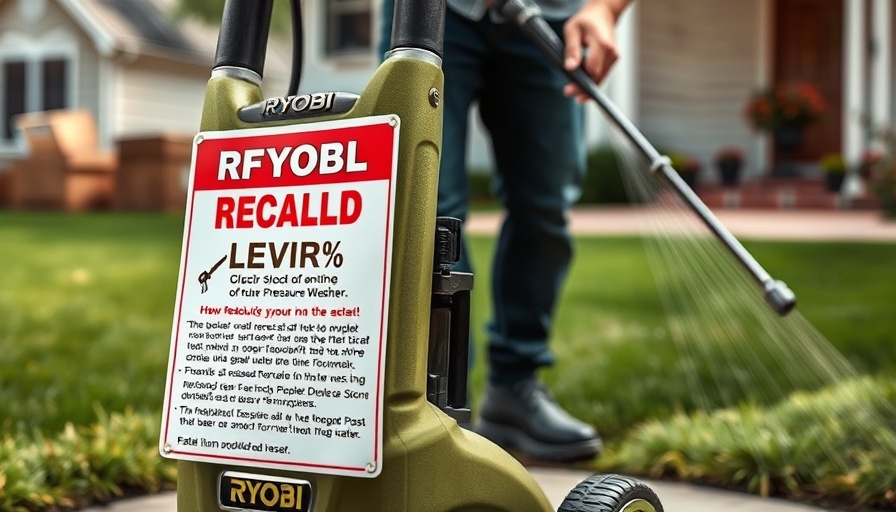
Urgent Recall Alert: Handling the Ryobi Pressure Washer Risk
The United States Consumer Product Safety Commission (USCPSC) has announced a significant recall involving over 750,000 Ryobi pressure washers due to serious safety issues stemming from defective capacitors. This recall highlights the importance of safety awareness when using DIY home improvement tools, particularly when monsoon seasons bring about higher cleaning demands. Here’s what you need to know to navigate this situation safely.
What’s at Stake with the Defective Pressure Washers?
The problem with these Ryobi pressure washers is alarming—the capacitors can overheat and burst, ejecting dangerous parts that can injure users and bystanders alike. TTI Outdoor Power Equipment, the parent company of Ryobi, reports shocking statistics: 135 incidents of overheating capacitors, including 41 resulting in explosions, have been recorded and have caused over 32 reported injuries, ranging from fractures to serious eye injuries.
Identifying the Recalled Models: Protect Yourself and Your Home
If you have a Ryobi brushless electric pressure washer, models RY142300 or RY142711VNM, produced between July 2017 and June 2024, it’s critical to assess your device. The units are identifiable by their green exteriors and certain features, such as the spray nozzle and a blue cap on the detergent tank. For those who purchased them from Home Depot or Direct Tools Factory Outlet, either online or in-store, it’s time to be extra vigilant.
Steps to Take: Repair and Prevention
The USCPSC urges customers to stop using these pressure washers immediately and visit Ryobi’s recall website to confirm eligibility for a repair. Fortunately, Ryobi is offering a repair kit free of charge, which includes a replacement capacitor and provides easy-to-follow installation instructions. If you lost your purchase receipt, there’s no need to worry—proof of purchase is not required for obtaining the repair kit.
Safety First: The Importance of Keeping a Safe Home
As more people embrace DIY home projects, understanding the safety features and risks associated with the tools we use is essential. While pressure washers are fantastic for tackling outdoor cleaning jobs—from sprucing up your patio furniture to revitalizing your home’s siding—they can present significant risks when faulty. Remember that engaging in home repair and cleaning projects should encompass not only aesthetics and efficiency but also, most importantly, safety.
Stay Informed: The Role of Community Awareness
Aside from following the recall instructions, consider spreading the word among family and friends. This information serves as a vital reminder to remain vigilant about product safety in our DIY endeavors. Sharing personal experiences and insights around safety measures can strengthen community awareness and foster a culture of safety.
It’s also worthwhile to stay updated on recalls and safety warnings through reliable sources like the USCPSC's website, which is a reputable platform for consumer safety information.
Looking Beyond: Future Predictions in DIY Safety
As DIY home improvement projects gain tremendous popularity, we can expect more innovations in safety features in future tools. Monitoring how manufacturers respond to safety recalls and addressing design flaws will be pivotal in ensuring consumer trust. Tools equipped with features that minimize risks during operation will undoubtedly become the gold standard for safety-conscious consumers.
Final Thoughts: Be a Proactive DIY Enthusiast
Exploring DIY home improvement can be immensely rewarding. However, it should never come at the risk of your safety. By understanding product risks, actively participating in recalls, and sharing knowledge with your community, you can enjoy your DIY projects while ensuring that you and those around you remain safe. It’s time to assess your pressure washer and promote a culture of responsible DIY home care!
 Add Row
Add Row  Add
Add 




Write A Comment